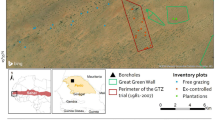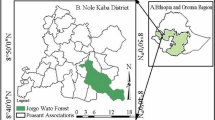Abstract
Miombo woodland, the most extensive vegetation formation in Africa, recovers well after cessation of disturbances from different land use practices on a site. The core strategy of sustainable miombo woodland management requires a detailed understanding of the implications of land use practices such as charcoal production, slash & burn agriculture and timber harvesting, on miombo woodland dynamics. The study undertook a comparative analysis of the influence of charcoal production, slash & burn agriculture and timber harvesting on woodland recovery at population and stand levels. Sites of known age after abandoning a specific land use were selected where the land uses were practiced in close proximity to each other. This involved characterizing miombo woodland based on some selected dominant species through developing stem diameter class distribution profiles. Most species in charcoal and slash & burn regrowth stands showed gradual development from one size class to another with this development being significantly (P < 0.0005) influenced by species rather than the disturbance category. The reason is that the key miombo species are light demanding and require maximum exposure to sunlight to grow fast. By contrast, species in single-tree harvested stands exhibited static stem diameter class profiles with no individuals in certain classes. The study concludes that whilst single-tree selection timber harvesting appears to show that the forest is intact at the stand level, it is actually not a sustainable management option at population level. It also concludes that charcoal production and slash & burn agriculture are necessary disturbances that enhance the establishment and development of the regeneration pool of the miombo woodland species.






Similar content being viewed by others
References
Boaler SB, Sciwale KC (1966) Ecology of a Miombo Site, Lupa North Forest Reserve, Tanzania III: Effects on the vegetation of local cultivation practices. Redditch Development Corporation, Redditch, Worcester and Forests Division, Government of Tanzania
Brown L (2001) Eco-economy: building an economy for the earth. Earthscan and Earth Policy Institute, London
Chidumayo EN (1990) Above-ground woody biomass structure and productivity in Zambezian woodland. Forest Ecol Manag 24:59–66
Chidumayo EN (1991) Seedling development of the miombo woodland tree Julbernadia globiflora. J Veg Sci 2:21–26
Chidumayo EN (1992) Seedling ecology of two miombo woodland trees. Vegetation 103:51–58
Chidumayo EN (1993) Responses of miombo woodland to harvesting: ecology and management. Stockholm Environment Institute, Stockholm
Chidumayo EN (1997) Miombo ecology and management: an introduction. Stockholm Environment Institute/IT Publications, London
Chidumayo EN (2004) Development of the Brachystegia-Julbernardia woodland after clear-felling in Central Zambia: evidence for high resilience. Appl Veg Sci 7:237–242
Chidumayo EN, Frost P (1996) Population biology of miombo trees. In: Campbell B (ed) The miombo in transition: woodland and welfare in Africa. CIFOR, Bogor, pp 56–71
Chirwa PW, Syampungani S, Geldenhuys CJ (2014) Managing Southern African woodlands for biomass production: the potential challenges and opportunities. Bioenergy from wood: sustainable production in tropics, managing forest ecosystems. Springer, Dordrecht, pp 67–87
Fanshawe DB (1971) The vegetation of Zambia. Government Printers, Lusaka
Forsyth T (2003) Critical political ecology: the politics of environmental science. Routledge, London
Geldenhuys CJ (1977) The effect of different regimes of annual burning on two woodland communities in Okavango. S Afr For J 102:32–42
Geldenhuys CJ (1993) The use of diameter distributions in sustained-use management of forests: examples from Southern Africa. In: Piearce GD, Gumbo DJ (eds) The ecology and management of indigenous forests in Southern Africa. Proceedings of an international symposium, Victoria Falls, Zimbabwe. Zimbabwe Forestry Commission and SAREC, Harare, pp 154–167
Geldenhuys CJ (2005) Basic guidelines for silvicultural and management practices in Mozambique. Report FW-04/05, FORESTWOOD cc, Pretoria
Graz FP (1996) Management of a Pterocarpus angolensis under the influence of fire and land use. Msc Dissertation. University of Stellenbosch, South Africa
Grundy MI, Cruz RM (2001) Impact of harvesting for building poles on the woodland structure of Derre Forest, Mozambique. In: Matakala P, Sitoe A (eds) Proceedings of the international workshop on Miombo woodlands in the new millennium: trends, uses and their role in sustainable development, Casa Msika, Manica, Mozambique, p 78–96
GRZ (1998) An overview of Copperbelt Province Forestry Action Plan. PFAP/DfID, Ndola
Hall JB, Rodgers WA (1986) Pole cutting pressure in Tanzanian forest. For Ecol Manag 14:133–140
Huston MA (1994) Biodiversity: the coexistence of species on changing landscapes. Cambridge University Press, Cambridge
Kayambazinthu D, Matose F, Kajembe G, Nemarundwe N (2003) Institutional arrangements governing natural resource management of the miombo woodland. In: Kowero G, Campbell BM, Sumaila UR (eds) Policies and governance structures in woodlands of Southern Africa. CIFOR, Bogor, pp 45–64
Lees HMN (1962) Working plan for the forests supplying the Copperbelt Western Province. Government Printer, Lusaka
Luoga EJ, Witkowski ETF, Balkwill K (2002) Harvested and standing wood stocks in protected and communal woodlands of eastern Tanzania. Forest Ecol Manag 164:15–30
Makungwa S, Kayambazinthu D (1999) Monitoring and evaluating productivity in miombo woodlands under co-management arrangements: The case of Liwonde forest reserve. In: Ngulube RM, Mwabumba L, Chirwa PW (eds) Proceedings of a National workshop, Sun and Sand Holiday Resort, Mangochi, Malawi, p 115–130
Mather A, Needle C (2000) The relationships of population and forest trends. Geogr J 166(1):2–13
McKenzie B (1988) Guidelines for sustained use of indigenous forests and forest products. Occasional report number 35, Foundation for Research and Development, Pretoria
Mistry J (2000) World Savannas: ecology and human use. Pearson Education Limited, Edinburgh
Mudekwe J (2006) Demography and dynamics of commonly harvested woody species in a protected indigenous forest in Zimbabwe. In: Bester JJ, Seydack AHW, Vorster T, van der Merwe IJ, Dzivhani S (eds) Multiple use management of natural forests and woodlands: policy refinements and scientific progress. Proceedings of a natural forests and Savanna woodlands symposium IV, Port Elizabeth, p 183–197
Nduwamungu J, Malimbwi RE(1997) Tree and shrub diversity in Miombo woodlands: a case study of kitulanghalo Forest Reserve, Morogoro, Tanzania. In: Imana-Encinas J, Klein C (eds) Proceedings of the international symposium on assessment and monitoring of forests and in tropical dry regions with specific reference to gallery forests. University of Brazil, Brazil, p 239–258
Peter MC (2005) Sustainable harvesting of non-timber plant resources in tropical moist forest: an ecological primer. http://www.worldwildlife.org. Accessed 12/11/12
Reader RJ, Bricker DB (1995) Value of selectively cut deciduous forests for understory herb conservation: an experimental assessment. For Ecol Manag 52:317–327
Schwartz MW, Caro TM, Banda-Sakala T (2002) Assessing the suitability of harvest of Pterocarpus angolensis in Rukwa Region, Tanzania. For Ecol Manag 170:259–269
Shackleton CM, Guthrine G, Main R (2005) Estimating the potential role of commercial over-harvesting in resource viability: a case study of five useful tree species in South Africa. Land Degrad Dev 16:273–286
Sileshi G, Akinnifesi FK, Ajayi OC, Chakeredza S, Kaonga M, Matakala PW (2007) Contribution of agroforestry to ecosystem services in the miombo ecoregion of eastern and southern Africa. Afr J Environ Sci Technol 1(4):68–80
Strang RM (1974) Some man-made changes in successional trends on the Rhodesian highveld. J Appl Ecol 111:249–263
Syampungani S (2008) Vegetation change analysis and ecological recovery of the Copperbelt miombo woodlands of Zambia. PhD Thesis, University of Stellenbosch, Stellenbosch
Syampungani S, Geldenhuys CJ, Chirwa WP (2010) The use of species-stem curves in sampling the development of the Zambian miombo woodland species in charcoal production and slash-and-burn regrowth stands. South For 72(2):83–89
Trapnell CG (1959) Ecological results of woodland burning experiments in Northern Rhodesia. J Ecol 47:129–168
Van Wyk GF, Everard DA, Midgley JJ, Gordon IG (1996) Classification and dynamics of a southern African subtropical coastal lowland forest. S Afri J Bot 62(3):133–142
Werren M, Lowore J, Abbot P, Siddle B, Hardcastle P (1995) Management of Miombo by local communities. University of Aberdeen and Forestry Research Institute of Malawi, Zomba
White F (1983) The vegetation of Africa: A descriptive memoir to accompany the UNESCO/AETFAT/UNSO vegetation map of Africa. UNESCO, Paris
Zagt RJ, Werger MJA(1998) Community Structure and the demography of primary species in tropical rain forest. In: NewberryDM, Prins HHT, Brown ND (eds) Dynamics of tropical communities. Blackwell, Oxford, p 193–220
Acknowledgments
The authors would like to thank World Wildlife Fund (WWF) and The Copperbelt University, Zambia for funding the study. Many thanks go to the following people: Mrs. Ferdinand Handavu, Biggie Ng’ona and James Mbunda for assisting in data collection. Lastly, thanks also go to the District Forest Offices, Copperbelt Province, Zambia and the traditional councilors for making their records available during case study selection.
Author information
Authors and Affiliations
Corresponding author
Rights and permissions
About this article
Cite this article
Syampungani, S., Geldenhuys, C.J. & Chirwa, P.W. Regeneration dynamics of miombo woodland in response to different anthropogenic disturbances: forest characterisation for sustainable management. Agroforest Syst 90, 563–576 (2016). https://doi.org/10.1007/s10457-015-9841-7
Received:
Accepted:
Published:
Issue Date:
DOI: https://doi.org/10.1007/s10457-015-9841-7




